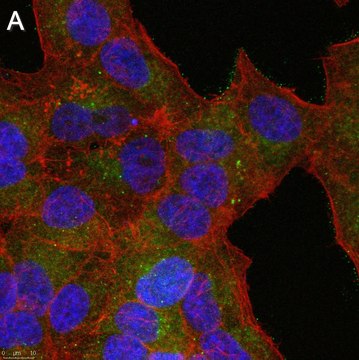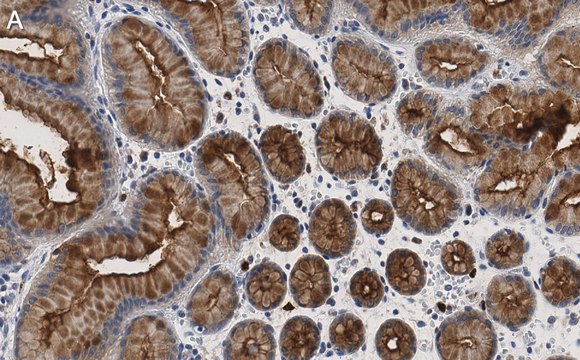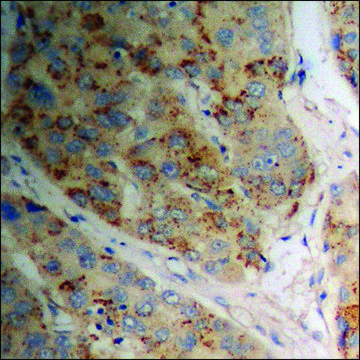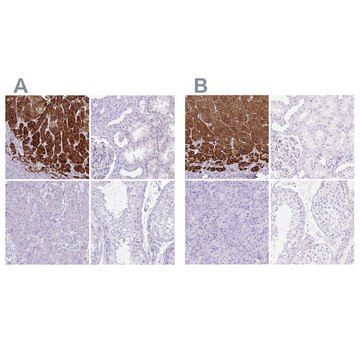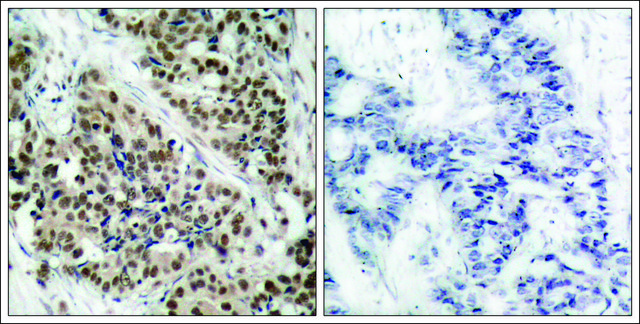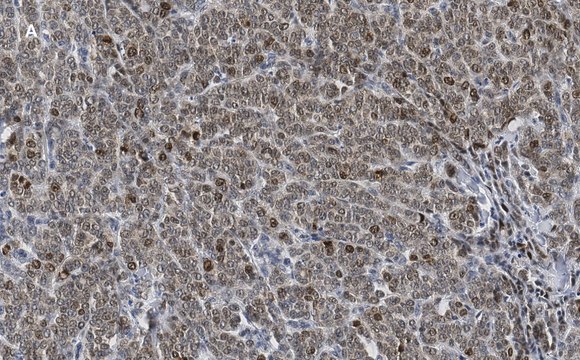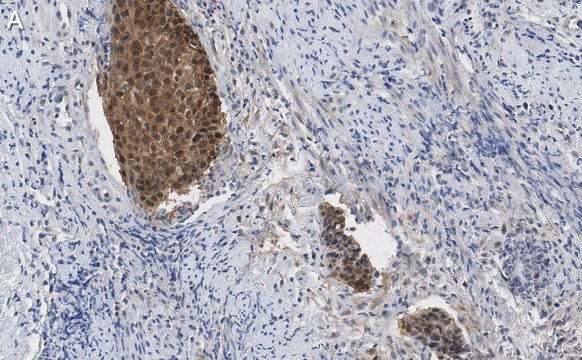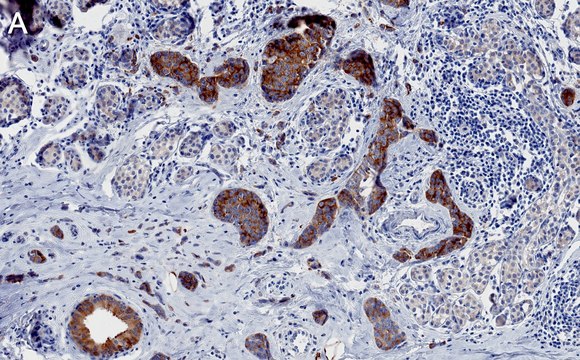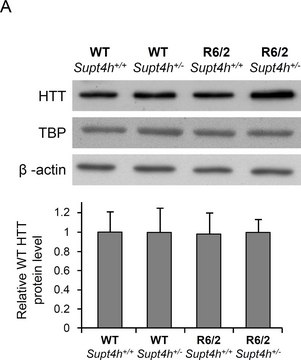一般描述
We are committed to bringing you greener alternative products, which adhere to one or more of The 12 Principles of Green Chemistry.This antibody is Preservative-free, produced without the harm or sacrifice of animals and exceptionally stable to allow for ambient shipping and storage if needed and thus aligns with "Waste Prevention", "Designing Safer Chemicals" and "Design for Energy Efficiency".
Click here for more information.
ZooMAb® antibodies represent an entirely new generation of recombinant monoclonal antibodies.Each ZooMAb® antibody is manufactured using our proprietary recombinant expression system, purified to homogeneity, and precisely dispensed to produce robust and highly reproducible lot-to-lot consistency. Only top-performing clones are released for use by researchers. Each antibody is validated for high specificity and affinity across multiple applications, including its most commonly used application. ZooMAb® antibodies are reliably available and ready to ship when you need them.
特异性
Clone 5L22 is a ZooMAb® Rabbit recombinant monoclonal antibody that specifically detects p53 protein phosphorylated on serine 15.
免疫原
KLH-conjugated linear peptide corresponding to 11 amino acids surrounding phosphoserine 15 from the N-terminal region of human p53.
应用
Quality Control Testing
Evaluated by Western blotting with recombinant fragment of human p53 surrounding phosphoserine 15.
Western Blotting Analysis (WB): A 1:1,000 dilution of this antibody detected recombinant human p53 fragment phosphorylated on serine 15 but did not react with non-phosphorylated construct (p53 construct: Courtesy of Dr. Jesse Rinehart, Yale University, School of Medicine).
Tested applications
Western Blotting Analysis: A 1:1,000 dilution from a representative lot detected phospho-p53 (Ser15) in lysate from Cos-1 cells treated with UV light.
Flow Cytometry Analysis: 0.1 μg from a representative lot detected phospho-p53 (Ser15) in one million A549 cells treated with UV light
Affinity Binding Assay: A representative lot of this antibody bound phospho-p53 (Ser15) with a KD value of 9.7 x 10-8 in an affinity binding assay.
Immunohistochemistry (Paraffin) Analysis: A 1:100 dilution from a representative lot detected phospho-p53 (Ser15) in human breast cancer and human colon cancer tissue sections.
Immunocytochemistry Analysis: A 1:100 dilution from a representative lot detected phospho-p53 (Ser15) in Cos-1 cells treated with UV light..
Peptide Inhibition Assay: Target band detection in lysate from Cos-1 cells treated with UV light was prevented by pre-blocking of a representative lot with the p53 phospho-peptide (Ser15), but not the corresponding nonphosphopeptide.
Note: Actual optimal working dilutions must be determined by end user as specimens, and experimental conditions may vary with the end user
This monoclonal Anti-phospho-p53 (Ser15), clone 5L22 ZooMAb® Rabbit Monoclonal, Cat. No. ZRB1542 is used in Western Blotting, Peptide Inhibition, Immunocytochemistry, Immunohistochemistry, Affinity Binding Assay, Flow Cytometry, for phospho-p53 (Ser15).
目标描述
Cellular tumor antigen p53 (UniProt: P04637; also known as Antigen NY-CO-13, Phosphoprotein p53, Tumor suppressor p53) is encoded by the TP53 (also known as P53) gene (Gene ID: 7157) in human. p53, a well-conserved phosphoprotein, is one of the best-known tumor suppressors. Human p53 consists of 393 amino acids assembled into five structurally and functionally different domains. It acts as a sequence-specific nuclear transcription factor that binds to defined consensus sites within DNA as a tetramer and represses transcription of a set of genes involved in cell growth stimulation, while activating a different set of genes involved in cell cycle control. It causes growth arrest before either DNA replication thereby providing a window for DNA repair or elimination of cells with severely damaged DNA strands. In some cell types, however, p53 activation results in apoptosis as a means of eliminating severely damaged cells. In normal, non-activated cells, the p53 signaling network is not active. However, p53 signaling is activated in cells as a response to various signals. Higher levels of p53 are found in a wide variety of transformed cells and it is mutated or inactivated in about 60% of cancers. Carcinogen-induced DNA damage, abnormal proliferative signals, hypoxia, and loss of cell adhesion are some of the most common signals that activate p53. The final outcome of p53 activation depends on many factors and is mediated largely through the action of downstream effector genes transactivated by p53. In unstressed cells p53 is latent and is maintained at low levels by targeted, ubiquitin-mediated degradation mediated by MDM2 and many other ubiquitin ligases. MDM2 functions as an E3 ligase that ubiquitinates p53 and forces its export from the nucleus to the cytoplasm, where p53 is degraded by the proteasome. p53 is shown to undergo several post-translational modifications that affect its activity. p53 acetylation on lysine 382 enhances its transcriptional activity. Site specific phosphorylations can affect its activity differently. Phosphorylation at serine 9 by HIPK4 increases its repression activity on BIRCS promoter. It can undergo phosphorylation on serine 15 upon UV treatment, which is enhanced by interaction with BTG3 Associated Nuclear Protein (BANP). Phosphorylation on serine 20 by Check 2 in response to DNA damage prevents its ubiquitination by MDM2. This ZooMAb® recombinant monoclonal antibody, generated by our propriety technology, offers significantly enhanced specificity, affinity, reproducibility, and stability over conventional monoclonals.
外形
Purified recombinant rabbit monoclonal antibody IgG, lyophilized in PBS with 5% Trehalose, normal appearance a coarse or translucent resin. The PBS/trehalose components in the ZooMAb® formulation can have the appearance of a semi-solid (bead like gel) after lyophilization. This is a normal phenomenon. Please follow the recommended reconstitution procedure in the data sheet to dissolve the semi-solid, bead-like, gel-appearing material. The resulting antibody solution is completely stable and functional as proven by full functional testing. Contains no biocide or preservatives, such as azide, or any animal by-products. Larger pack sizes provided as multiples of 25 μL.
重悬
30 μg/mL after reconstitution at 25 μL per vial. Please refer to guidance on suggested starting dilutions and/or titers per application and sample type.
储存及稳定性
Recommend storage of lyophilized product at 2-8°C; Before reconstitution, micro-centrifuge vials briefly to spin down material to bottom of the vial; Reconstitute each vial by adding 25 μL of filtered lab grade water or PBS; Reconstituted antibodies can be stored at 2-8°C, or -20°C for long term storage. Avoid repeated freeze-thaws.
法律信息
ZooMAb is a registered trademark of Merck KGaA, Darmstadt, Germany
免责声明
Unless otherwise stated in our catalog or other company documentation accompanying the product(s), our products are intended for research use only and are not to be used for any other purpose, which includes but is not limited to, unauthorized commercial uses, in vitro diagnostic uses, ex vivo or in vivo therapeutic uses or any type of consumption or application to humans or animals.

